The third instalment of weblogs starts with a reality check.
Site number one:
winnipegfreepress.com/local/students-sue-over-midwifery-program-144072116.html
In chasing down information on the exciting-to-me aboriginal orientated midwifery course in northern Manitoba which I highlighted in my last weblog, Google revealed a newspaper article in the Winnipeg Free Press March 24, 2012: “Students sue over midwifery program: allege UCN failed to provide an education”. Oh dear.
Four students from the University-College of the North (UCN) claimed the college had insufficient instructors, failed to provide adequate supervision, and neglected to ensure students attended the required number of births to complete their courses. Not only that, but the program was shutting down and although students had been invited to transfer to the midwifery program in Winnipeg, the two aboriginal spots had already been filled leaving no room in the class for them to finish their studies.
The article stated there hadn’t yet been one graduate in the six years of the midwifery program instead of the 22 graduates I had described. Working from University statistics. I must have interpreted the numbers incorrectly. Half the KOBP students had left the program for ‘family reasons’.
The article further explained that in the province of Manitoba there are only 44 registered midwives, not all of them practising. Given those low numbers, it is understandable the students could not get enough mentoring. Politicians blamed each other for the midwife shortage, citing failure to initiate more classes. But isn’t that what they were trying to address by opening the UCN class?
The UCN says it is restructuring and will reopen the program; no date was provided.
I have learned a valuable lesson – doesn’t matter how recent the webpage, check it someplace else or you may end up with stale data like I did.
Site number two:
http://www.cbc.ca/trailbreakers/main-blog/2012/08/08/high-school-program-aims-aboriginal-kids-at-healthcare-field/
After that shock, I needed something reliable so I turned to CBC radio. Trailbreakers is a program focused on First nations issues.
Rina Bright is an educator/teacher at the Children of the Earth School in Winnipeg in a special program aimed at Aboriginal students who want to become health care workers. The students get a chance to work in clinics and assist in surgeries. Bright stays with the students for four years which I think addresses the need for mentorship and community support, elder wisdom and guidance. This was a very uplifting site and good for a discouraged soul (mine!), friendly and optimistic but really no more than light reading.
Site Number three:
wsd1.org/cote/welcome.html
Just to make sure it really existed and to test my trust in the CBC radio site, I searched for the Children of the Earth high school in Winnipeg. The school was there but their web page was last updated in 2008, unfortunately.
They claim a pedagogy that is culturally based, flexible and centred on the needs of the students. Aboriginal values and perspectives are incorporated into everyday life. “We believe in a holistic approach to education that integrates the physical, academic, social and spiritual well being of our students”, a sentiment that mirrors the medicine wheel model discovered at the University of Saskatchewan web site (reminder: aerc.usask.ca/projects/healthtraining.html).
Macleans magazine included this Aboriginal high school amongst their 2005 Top Ten High Schools in Canada – a silly reference that reassured me greatly.
A reassuring site but not really meaty enough for anything more than a nice visit.
Site number four:
http://ctlt.ubc.ca/2012/09/25/aboriginal-initiatives-classroom-climate-series/
Staying with the school theme, site number four comes from UBC: “What I learned in Class Today: Aboriginal Issues in the Classroom”, a gold mine of information and advice. Thanks to classmate Janet B. for the introduction to the UBC web page.
One Aboriginal student said she “trained myself to be really diplomatic” so as to carry the responsibility of representing all things Aboriginal to every class but some days she felt it too heavy a burden, “like a brick on my back”. Another section encouraged non-Aboriginal instructors to “speak through the discomfort and not be silent because of it” when faced with Aboriginal course content that was foreign to them.
There are good, solid, practical tips for teachers to incorporate Aboriginal topics to classrooms and how to deal with the discomfort. A very good site.
Site number five:
http://.unsettlingamerica.wordpress.com/
Angry webpages are not usually my cup of tea but they suddenly felt good after saccharine course promos for no-longer-existing courses. Sometimes it’s good to have a little bit of acerbity for balance.
Unsettling American: Decolonization in Theory and Practice is an energetic website filled to the brim with links to other energetic websites devoted to unsettling the settlers. Snappy titles attract the eye: Unsettling Ourselves: Reflections and Resources for Deconstructing Colonial Mentality began with an explosive “Columbus was insane” and the muscles flexed from there. Although it’s good to know what’s out there, this site is not helpful for recruiting or retaining healthcare workers. Heaven help me when one of these angry students enrols in my class.
